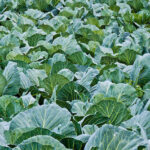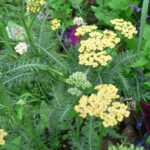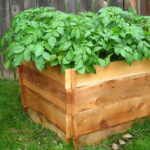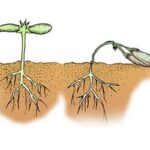Marjoram is in my top five favorite culinary herbs to grow at home. I’ve been growing marjoram in patio pots for years and have discovered that sweet marjoram can take a simple dish from good to delicious!
Popular in Italian and Greek cooking, marjoram is a versatile herb that can be used fresh or dried in salads, sauces, dressings, and in a multitude of meat dishes. Its flavor is delicate with aromatic tones of sweet woody pine and citrus. My favorite way to use marjoram is to toss fresh marjoram leaves into roasted vegetables at the end of cooking, letting the heat dissolve the herby flavor into the savory yumminess.
As with most herbs, marjoram has been used since ancient times and has many medicinal benefits. The Greeks believed that marjoram promoted longevity and used it in everything from food, medicine, perfume, and cosmetics. Medicinally, marjoram has anti-inflammatory and anti-microbial properties that aid digestion and fends off flu and infections.
Quick Care Guide
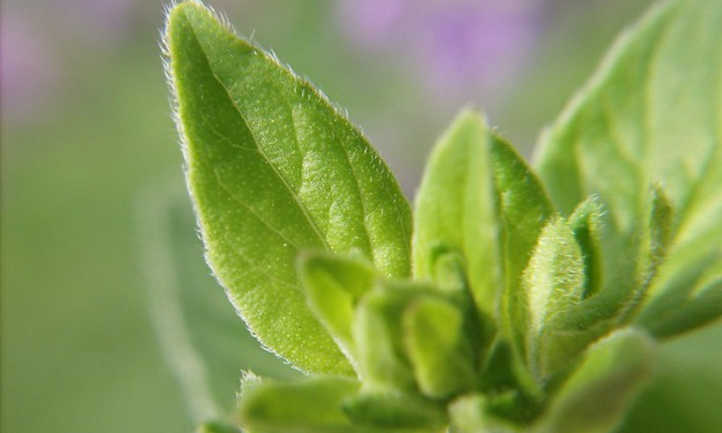
| Common Name(s) | Marjoram, sweet marjoram, knotted marjoram |
| Scientific Name | Origanum majorana |
| Days to Harvest | 70-90 days from seed |
| Light | Full sun |
| Water: | Low water requirements |
| Soil | Free draining silt, loam, sandy |
| Fertilizer | Minimal |
| Pests | Aphids, spider mites |
| Diseases | Botrytis, powdery mildew, rust |
All About Marjoram
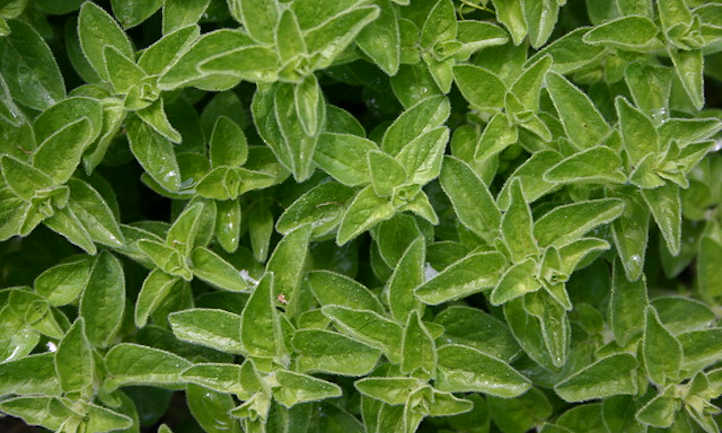
The scientific name for marjoram is Origanum majorana, and it’s commonly known as marjoram, sweet marjoram, or knotted marjoram. It originates from the Mediterranean and North Africa but is also believed to have origins in western Asia.
Marjoram is a slow-spreading tender perennial, growing to 12-24 inches tall (30-60cms) and 18 inches across (45cms), forming a bushy mound when mature. It spreads by root rhizomes and is self-seeding. A marjoram plant left unmanaged will self-seed widely in the garden. Pruning flowering stems in summer will reduce the volume of flowers and seeds produced. You can also divide mature plants every few years to restrict the spreading root rhizomes and produce lots of free plants!
Leaves are pale green and slightly hairy growing opposite on green/brown square woody stems, which can become leggy if grown in shade. Flower buds grow on apical and lateral extremities forming tight green knots opening into white flowers. This is where the name ‘knotted marjoram’ comes from.
Marjoram is often confused with its close cousin oregano. They are both from the genus Origanum in the mint family, Lamiaceae, but are completely different species; marjoram is Origanum majorana, and oregano is Origanum vulgare.
The key differences between marjoram and oregano are their flowers and flavor. Marjoram flower buds open to white or purple florescences, whereas oregano flowers are pink. Flavor-wise they both have similar base notes, but oregano is much stronger and spicier and requires highly flavored food to carry it, such as pizza. Marjoram’s aroma and flavor is milder and often preferred by chefs because it does not overpower food.
Like most Mediterranean herbs, marjoram likes to grow in well-drained soil in full sun. It is not frost-tolerant and is grown as an annual in many northern regions. In these areas, it’s best to grow marjoram in containers that can be moved indoors over winter.
Planting
Marjoram plants can be moved outside after all risk of frost has passed. After weeks/months of growing indoors, it’s important to condition plants to their new environment by hardening them off each day. Set plants outside in a sunny sheltered location during the day and bring them indoors at night. After about a week, plants are ready to go into their final growing positions in the garden.
Choose a sheltered sunny spot with well-drained soil to grow marjoram. For plants grown in a container, mix perlite or horticultural grit into your potting compost to help with drainage. Elevate containers off the ground using feet or risers to allow pots to drain freely. Marjoram plants can be grown in pots by themselves or alongside other herbs with the same growing requirements, such as oregano, thyme, and rosemary.
Marjoram Care
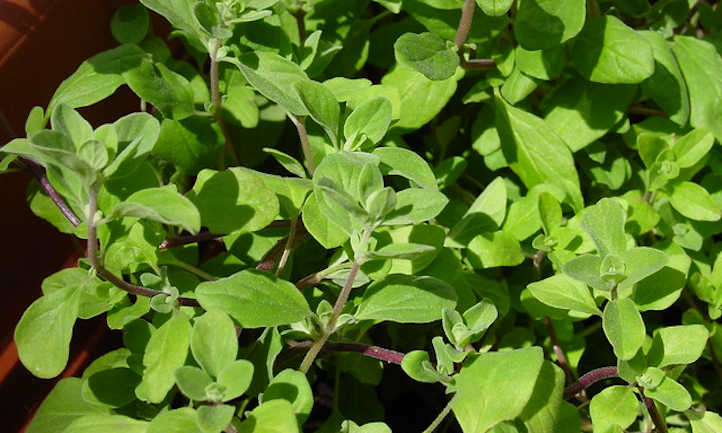
Marjoram is easy to care for. If you don’t have the perfect growing conditions in your garden, you can grow this aromatic herb in containers or even a window box.
Sun and Temperature
Marjoram grows best in USDA zones 6-9, in full sun with at least 6 hours of direct sunlight per day. An ideal temperature range to grow marjoram is 60-70ºF (15-20ºC). Although marjoram can survive brief cold spells, prolonged periods of frost will kill it. For this reason, marjoram is grown as an annual herb in northern regions or grown in a container to be brought indoors in winter.
Water and Humidity
Water marjoram early in the morning before the full heat of the day. Young transplants require regular watering until they are established. Mature plants are more drought-tolerant and benefit from letting the soil dry out between watering. However, they are less tolerant of having their roots wet and can quickly develop root rot.
Use a timed soaker hose or a watering can directed at the ground. Marjoram can develop mildew in high humidity especially if watered overhead. Provide adequate spacing between plants to encourage good air circulation and reduce watering over the winter months.
Soil
Marjoram is not picky when it comes to soil. It grows pretty well in most soil types as long as it’s free draining. Ideal soil pH ranges from 6.5 to 7.5. If your garden soil is heavy, try growing marjoram in a container or raised bed.
Fertilizing
Over-feeding leafy herbs can stimulate weak leggy growth and negatively affects the aroma and flavor of the leaves. Young seedlings will benefit from a weak balanced liquid feed in late spring. Mature plants can be given a liquid seaweed feed over the summer months if plants need a boost.
Pruning
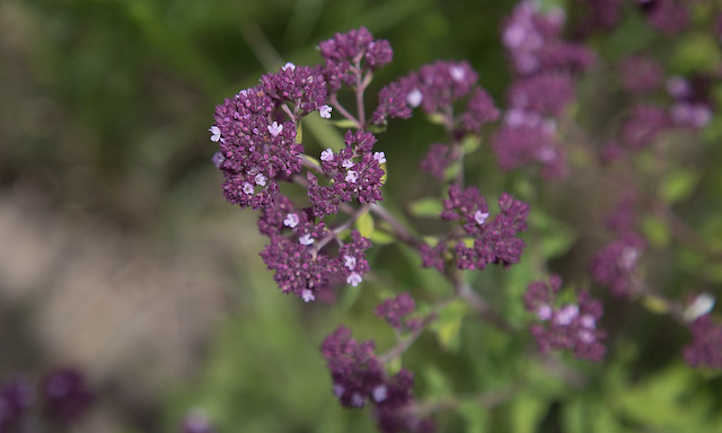
The ideal times to prune marjoram are as follows: In late spring, prune leaves and stems back to a branching leaf node to develop bushy plants; in mid-summer prune to encourage fresh vegetative growth and to prevent flowering and in autumn prune all stems back to around 2-3 inches to prepare the plant for winter.
For best flavor, try not to let your marjoram plant flower, as it can add a bitter tone to the leaves you harvest.
Propagation
Grow sweet marjoram from seeds, cuttings, or divisions or layering branches.
Start marjoram seeds indoors in early spring. Sow seeds into compost ¼ inch (1cm) deep. Keep soil moist and at a consistent temperature of around 70ºF (21ºC). Germination should take around 7 days and once seedlings emerge continue to grow indoors in a bright, sunny location. When all risk of frost has passed, and seedlings are at least 2-3 inches tall, they are ready to be hardened off in preparation for planting outside.
Marjoram seeds can be sown directly into the garden after the last frost. Sow seeds thinly into well-drained soil ¼ inch (1cm) deep and water. When seedlings emerge thin to 6 inches (15cm) when they are a few inches tall and then to 12 inches (30cm) when plants begin to fill out.
Take cuttings from early to mid-summer from a healthy marjoram plant. Snip approximately 10cm of top growth from non-flowering stems cutting just below a leaf node. Strip all leaves from the bottom 5-6cm and insert stems into a prepared pot containing a mix of perlite/horticultural grit and potting compost. Place the pot into a propagator or cover with a clear plastic bag to maintain warmth, moisture, and humidity. Ventilate the cuttings every few days and check for signs of mold or rot. Roots should have developed after 3-4 weeks. Gently separate each new plant and pot individually. Harden off as outlined above and plant into the garden 12 inches apart, after the last frost.
Mature marjoram plants can be divided in early spring. Dig around the plant with a spade and gently lever the plant from the ground. The size of the plant will determine the number of divisions. Divide using a knife and plant into new locations as soon as possible. Alternatively, divisions can be grown in a pot.
A sprawling marjoram plant can be easily layered by pinning down a healthy outer branch to the ground, covering it with soil and watering regularly. In a few weeks, the layered stem will have formed roots and can be cut from the mother plant and planted into its new home.
Harvesting and Storing
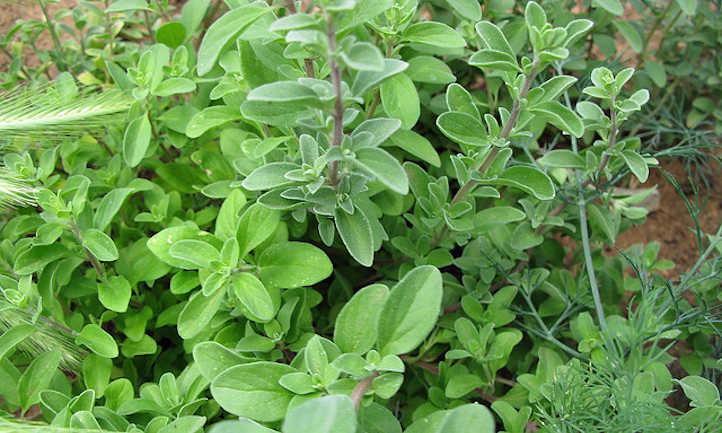
Marjoram leaves can be picked regularly and used fresh or dried for longer shelf life.
Harvesting
You can harvest marjoram leaves when plants are around 5-6 inches. Allow plants time to recover in between each harvest. Avoid taking more than a third of the plant at a time to ensure it has enough foliage to aid it in regrowth.
Storing
Fresh leaves can be wrapped in clingfilm or damp kitchen paper and stored in the refrigerator for a few days. Leaves can also be frozen and stored in a ziplock bag in the freezer and used as needed.
Marjoram makes a great dried herb. Hang bundles upside down to dry in a dark, well-ventilated room. When completely dry, crumble the leaves and store them in an airtight container. For faster results dry leaves in a dehydrator.
Troubleshooting
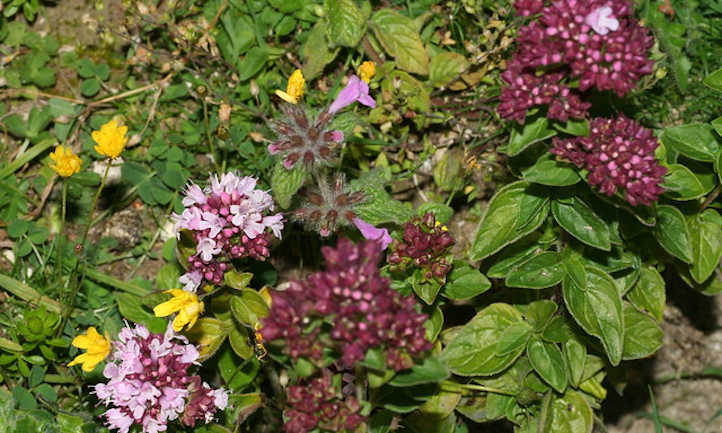
Growing marjoram in the garden is pretty straightforward. Here are a few tips to care for your plants and keep them looking healthy throughout the season.
Growing Problems
Problems when growing marjoram are usually soil, light, water, or temperature related. Heavy soils and too much watering will result in root rot and death of the plant. To avoid this, grow marjoram in free-draining soils, in a sunny location, and only water when the soil has dried out.
As a tender perennial, marjoram can tolerate low temperatures but will not survive prolonged periods of frost. In northern regions, it’s recommended to grow marjoram in pots that can be protected indoors over winter or grow it as an annual herb.
Pests
Aphids (Aphidoidea) feed on the sap of new plant growth, dehydrating the plant and damaging leaves and buds. They also carry a multitude of other plant diseases. Treat biologically, through the release of beneficial insects that feed on aphids, such as ladybug larvae (cococinella septempunctata). Or spray with a good organic insecticidal soap or neem oil. Squishing aphids with fingers or a quick blast of water can help reduce numbers.
Spider mite (Tetranychidae) adults are reddish-brown, living in large colonies on the underside of leaves and thriving in hot, dry environments. You will know if you have spider mites if you see a fine webbing between leaves and stems. Plants will also show signs of decline as leaves turn yellow and drop off. They are resistant to most pesticide products on the market so it’s best to remove and destroy the worst affected parts or entire plants to prevent the problem from spreading.
Diseases
Grey mold, Botrytis cinerea, is an airborne disease that can affect marjoram plants during mild, damp weather. Unhealthy or damaged plants are particularly vulnerable. Symptoms include wilt and brown/grey discoloration of leaves and stems with furry growth that contains spreading fungal spores. Affected branches can be removed but this provides new wounds for infection to take hold again. Good plant husbandry can help in the prevention of grey mold, such as handling plants with care when harvesting; clearing away leaves or other decaying debris; and providing adequate spacing to allow good air circulation.
Powdery mildew is a fungal disease that can affect marjoram in hot, humid, shaded conditions. It grows as a white thick dust on leaves, inhibiting photosynthesis and hindering growth. Leaves eventually turn yellow and die.
To prevent powdery mildew, maintain good garden hygiene, removing infected foliage to prevent the disease from spreading and reinfection in subsequent years. Provide adequate sunlight and avoid conditions the disease thrives on. Prune overcrowded areas to allow good air circulation. Spray with an organic fungicide such as sulfur, neem oil, or potassium bicarbonate, prior to or on first sight of disease.
Fungal rust appears as yellow/orange spots on marjoram leaves spreading via wind or water droplets. Early treatment with a good organic fungicide can slow the spread of the disease, but generally, it is difficult to treat. Infected plants should be pruned to ground level and the foliage destroyed.
Frequently Asked Questions
Q: Is marjoram an annual or perennial?
A: Marjoram is a tender perennial that is often treated as an annual in colder, northern climates.
Q: How long does it take to grow marjoram?
A: Grow marjoram from seed and it will be ready for harvest in 70-90 days.
Q: Should you let marjoram flower?
A: Try not to let your marjoram plants flower if you wish to harvest the leaves. Flowering can make the leaves taste bitter. Harvest marjoram throughout the growing season and before flowering for the best flavor.
Q: Is marjoram the same as oregano?
A: Although marjoram and oregano are from the same genus Origanum, they are completely different species; marjoram, Origanum majorana, and oregano, Origanum vulgare. They look the same but have a different flavor and aroma.


